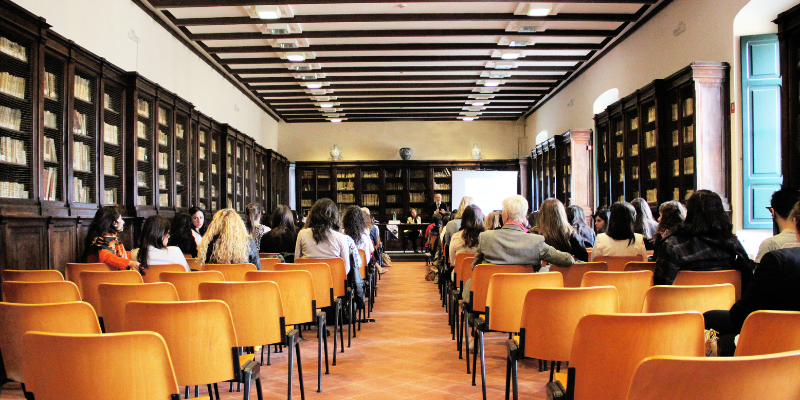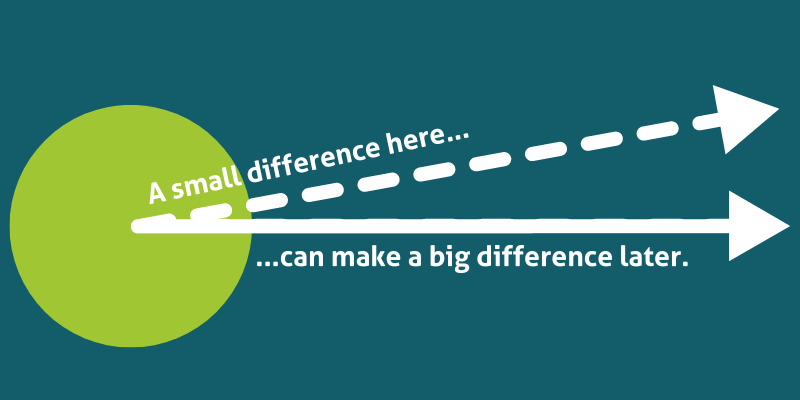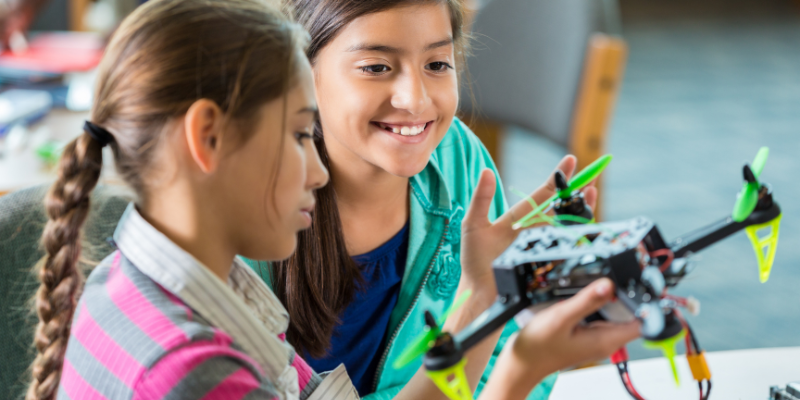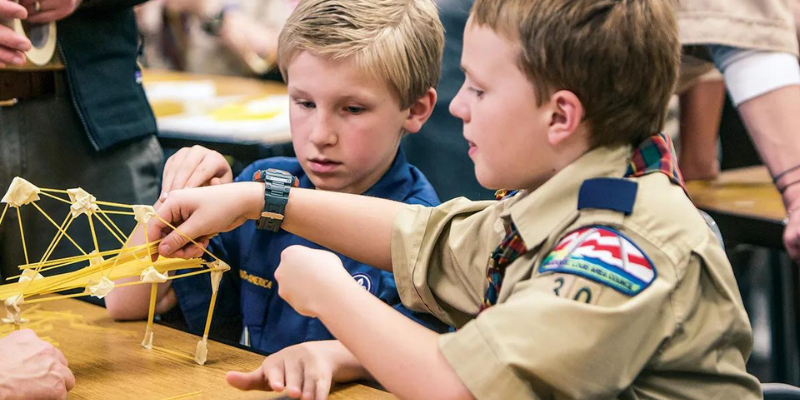Afterschool and out-of-school programs often provide a safe space for kids to encounter STEAM without worrying about the pressure of grades. They’re also perfect for experimenting as students work on further developing skills they've learned in the classroom. In afterschool programs, educators have more freedom to introduce ideas they may not have time to work into a regular lesson plan.
For this latest Teacher Talk, I chatted with Mallory Davis, a curriculum director who’s worked extensively with afterschool leaders. She’s very passionate about the importance of STEAM, and we had a wonderful conversation about how to integrate STEAM and SEL, where technology could head, and the benefits of afterschool education.

So, to get started, could you tell me about yourself and your background in education?
My name is Mallory Davis. My pronouns are she/her. As far as my background, I've had about 10 years of experience in curriculum and content development for grades K–12 in the afterschool time. [That includes] STEM, SEL, character development, coding, arts, literacy, and career and workforce readiness.
I’ve had experience with running STEAM programs at a national level with Boy Scouts of America. Two of the years I was there, I was revamping their entire national STEM program. Then, the last two years, I was interim director and was overseeing 19 participating chapters of that program. I have heavy experience in relationship building, resource provider networking, program management and development, and content and curriculum. I also had three years working as a Director of Training and Development for afterschool professionals—training anyone from 18-year-olds with no experience to certified teachers.

Why did you get into the field of curriculum development and afterschool programming in the first place? What inspired you?
I was going to school for my Masters in Communication and needed a part-time job. My friend at the time was teaching after school with Girl Scouts of Northeast Texas, and I said, “I could totally do that, because I love kids.” I joined that space, and during the next semester, they had an opening for the program manager position. I loved it so much that I decided that was what I wanted to try—I didn’t want to go to grad school anymore. It was a big risk to drop out.
I absolutely fell head over heels for running an out-of-school program, overseeing a team, and writing the curriculum. We were delivering character development curriculum to girls from 6th to 8th grade. I did that for several years, and then the former Vice President of the Girl Scouts of Northeast Texas informed me of another opportunity for some curriculum revamp. She asked me to apply because she knew I loved writing curriculum. I love teaching in front of kids, but know my impact stretches further when writing the lessons.
That’s so cool. A curriculum goes out to so many more people than when teaching a class.
Yeah! As much as I love the frontline work, I do have a true passion for behind-the-scenes work. The scale and scope of impact increases—I went from impacting 1,500 youth to 20,000 youth.
I love to say that I’m in the business of the one degree. If I can shift just one kid’s thinking by one degree, it can completely change the trajectory of their entire life. If you plot out a point and draw a line and have just one degree of change in the line, over time, it’s a totally different path. I fell in love with changing lives. You may never see the change, but you’re sowing the seeds that will inevitably bring on change in some way. I just hunt for the one degree. That’s all I need.

How do you craft afterschool curriculum that inspires that one-degree shift?
The afterschool time is not the melody of education. Our teachers are the melody. Afterschool time is the harmony that can support the melody. But, you can’t have the harmony without the melody. Our teachers have a huge responsibility. They have 45 minutes to educate a kid and develop their character: leadership, servanthood, empathy, respect, inclusion. Their plates get really full. And, when it comes to standardized testing, they have to focus and get lesson plans done. They have to teach the kids the right answers.
In afterschool time, I get to play a little more. It’s more free. I look at standards so that my curricula align with the school day, because the more you practice something, the more you are going to learn it. If I can align lessons with the school day, it's reiterating what they’re learning.

But I don’t have to guarantee that students are going to memorize the right answer. I can say, “Okay, you didn’t get it. How did that feel? If you could do it again, what will you do differently? When is another time that you didn’t get something right? How did you react? How would you like to react next time?”
In the classroom, students might have the fear of failure. Is it pass or fail? Am I going to be held back? This out-of-school time can present learning in a more hands-on way, which often makes it more approachable for kids. Then, when they see the same topic in school, it is less intimidating. I'd love it if kids walked away with a growth mindset along with the ability to try hard, feeling a higher sense of self-efficacy and also a positive sense of self.
So, with the freedom in these afterschool and out-of-school STEAM programs, have you built any STEAM tools into your curricula? How do those fit in?
When I was working with the Boy Scouts, I wanted to diversify our offerings and do some coding. Coding with robots is great, because many of the robots often have an enormous database of free lessons and tutorials to help along the way. Kids would meet once a week for 90 minutes. We’d go through robotics, but also tie in a career to expand their horizons. You can work at Google and not be a coder, you know.

We also incorporated social-emotional learning. We would draw parallels between coding and their real worlds. Coding has to be very specific, and the computer has to take time to understand. We’d say, “The computer needs to listen and pay attention. When do you do that? Are you actively listening?” That is our opportunity to talk about detailed communication and what that means in healthy relationships and social awareness.
I love how STEAM builds so many more skills than just coding. Even as I experiment with the robots at Eduporium, I find myself building logical thinking. It works on me!
It applies more to the whole child than most people would think. You make decisions differently. I think you approach perseverance differently. Attention to detail, time management, following instructions…
So many things our kids access are quick. They want access, they want answers, they want something to do that for them. But when you give them a specific set of instructions and have them slow down and take their time, they are activating that prefrontal cortex. Then, when they are out in the real world later on, they can analyze problems and have logical thinking.
I always tell people we’re not going to get the iPhone 28 if we don’t put kids in front of coding, marketing, innovation, brainstorming, collaboration, and tech. STEM is important because we want to see the future. With climate change, it can’t just be politics, it’s also STEAM. We could start recycling, but we have to think bigger. What are the chemicals behind plastic? Why does it not break down? We need to talk more about it with kids.
Besides what we’ve already said, what is important about STEAM?
A lot of things come to mind. STEAM is everywhere; you can’t get around it. If you’re reading, there had to be engineering to build the book. There’s science behind the biology of the paper and the ink. There’s also social studies behind the written word, and logical and analytical thinking in building the language.
The definition of technology is not just computers; technology is innovation and something new. It’s the chair that I'm sitting in. It’s the bottle that’s holding my water. STEAM is everything. The challenge lies in demystifying the scariness of STEAM.
So, how can we demystify STEAM?
People think, “I’m not a coder. I’m not a mathematician. I can’t lead STEAM activities. Only certain people can do it.” But I just read some research about the left and right brain. The left brain is more analytical, and the right brain is responsible for arts and creativity. People will often say, “I’m left brained. I’m not an artsy person.” It’s true that the sides of your brain are more responsible for each area, but research shows that your brain accesses both sides equally. You just have to have passion.

I think kids have a stigma that STEAM is just for smart kids. We need to change it. It’s for passionate kids. It’s for adventurous kids. It's for curious kids. If we're able to embed curiosity and passion and adventure and risk into students, they can try those things. We each have a responsibility to demystify STEAM, and we have a job to make it fun, because it is fun.
And STEAM is hard. We wouldn’t lie about it. Kids have adult-sized emotions, so when kids are scared of something new, that fear is real. If we can give them the character tools to manage the emotions, that will help demystify STEAM and increase curiosity. It will help them learn how to approach a challenge.
I agree, and I see the same thing. Kids are terrified of math because they think math is hard, but it doesn’t have to be hard.
The math experiences they know are only ever in school. If they get a bad grade, they can't play sports or they don’t go on to the next grade. There is a lot riding on it for them, which puts a lot of pressure on little brains with adult-sized emotions. Then they’re in this rut, thinking, “I’m scared of math.”

Our self-talk is very powerful. When you practice gratitude, your brain rewrites itself. When kids say, “I hate math. It’s scary. It’s hard. I’m bad at it,” it’s rewiring their brain to have that relationship with math. So, in an after-school program, we have a responsibility to support them. If I try approaching fractions, for example, with blocks or pies, it starts to loosen them up a bit.
What do you think is next with STEM education? There are plenty of hot topics right now, like cybersecurity, AI, and SEL, so where do you think we’re going next?
I have a lot of thoughts about AI and ChatGPT. I love it. When man invented fire, they probably all had to learn the hard way about how to control it. Maybe they hadn't realized that it would spread so fast. I think we're on the same precipice. AI is the new version of fire. It’s going to be greatly beneficial and it'll totally reinvent humanity as we know it, just like fire did.
But we’re going to have areas in which we fail at controlling it. The future of STEAM involves learning how to take advantage of the technology and not letting the technology take advantage of you. I do have hope in the character of the generations that can continue to build AI tools. The younger generation is already starting to show empathy and find their voice. Thus, the future of STEAM is about advancing technology with character and integrity. It’s got to be an incredible balance.
What’s something that’s been personally rewarding for you about working in education?
When I was at Girl Scouts, Frozen had recently come out. We had a box called Let It Go, and we decorated it using some sparkles, stickers, and printouts from the movie. Our audience was middle school girls, and we had them write down things that they needed to let go of on slips of paper, and they’d put it in the box.
My team told them the power of physically doing this. We said, “When you walk out of this classroom, we want you to try to let it go.” I’ve held on to a lot of those [papers]. It reminded me of how much these kids need trusted adult relationships.
In my role, you can feel behind the scenes. You can feel like you miss all the action because you’re not on the frontline. But you're impacting children, and it’s hard work. The hard work is the most important work. What I love the most is being able to pour into students’ lives and look for that one degree. Regardless of the topic of the lesson, we find the one degree and leave that kid feeling inspired, even for a moment.
If you're interested in sharing your story as an educator, please contact Eduporium's Content Associate, Kara Applegate, or try applying for our monthly educational technology grant. And, don't forget to follow us on Twitter and Instagram so you don't miss our next featured interview!



